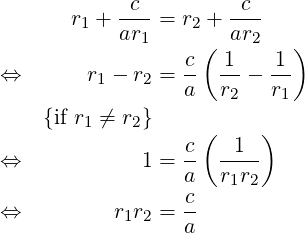
[This page is auto-generated; please prefer to read the article’s PDF Form.]
Above we could establish the relations about sum and product of the roots (though with some assumptions). There are other ways also to arrive at these relations. Equation (2) for r1, and similar one for r2, can be combined and re-arranged as:

Also, combining equation (4) for r1 and similar one for r2:

But these derivations involved some assumptions (like r1≠r2), and so are not thorough. There is a complete proof of these relations based on the Factor Theorem (which itself is a consequence of the Polynomial Remainder Theorem). Due to this theorem, if r1, r2 are roots of (1), then, (x − r1) and (x − r2) are factors of the quadratic polynomial on the LHS of (1). So,


 )∕2a, and then simplifying r1 + r2 and r1r2.
)∕2a, and then simplifying r1 + r2 and r1r2.
■
Copyright © 2021 Nitin Verma. All rights reserved.